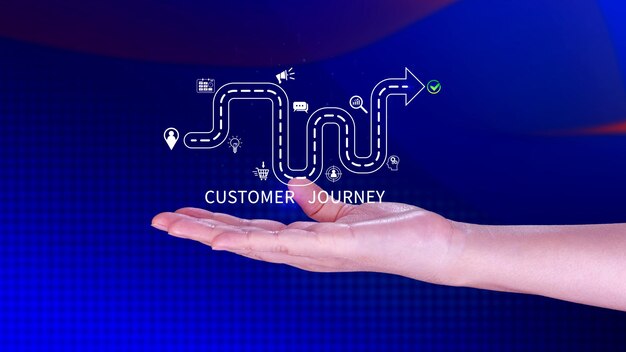
In recent years, businesses have made significant progress in understanding their customers’ paths from awareness to purchase and beyond. Customer journey analytics has been a key driver of this progress. But as customer behaviors evolve and digital touchpoints multiply, the tools and methods used to track and analyze these journeys have also grown more sophisticated.
Let’s take a closer look at what’s new in customer journey analytics and why CX leaders should p...
ay close attention to these developments.
1. The Shift to Real-Time Journey Tracking
Traditionally, customer journey analytics focused on historical data—what happened, where customers dropped off, and which touchpoints were most effective. Today, there’s a strong shift toward real-time journey tracking, which allows businesses to monitor and respond to customer behavior as it happens.
This change is driven by customer expectations. People don’t just want personalized experiences; they expect businesses to respond to their needs instantly. Real-time analytics helps companies offer timely recommendations, fix issues before they escalate, and deliver better service when it matters most. For example, a bank that notices a customer repeatedly failing to complete a mobile transaction can trigger a support message or offer assistance before frustration sets in.
2. Smarter Use of Behavioral and Intent Data
Modern journey analytics tools are moving beyond surface-level interactions like page visits or clicks. They’re now incorporating behavioral and intent data—subtle cues that indicate what a customer might be thinking or planning to do.
This includes tracking how long someone spends reading a product description, whether they revisit a certain FAQ page, or if they hesitate before completing a form. These signals, when analyzed in context, offer valuable insights into customer intent. Businesses can then tailor follow-up communication accordingly—be it a special offer, a product recommendation, or a simple nudge to re-engage.
3. Integration Across Channels and Teams
Another key development is the integration of journey data across departments and channels. In the past, marketing, sales, and support teams often worked in silos, each managing their own tools and data sets. As a result, customer journeys were fragmented.
Today, customer journey analytics platforms are designed to unify data from websites, mobile apps, email campaigns, call centers, chatbots, and even in-store interactions. This gives CX leaders a more holistic view of how customers engage with the brand, where they encounter friction, and how those moments impact their overall experience.
For example, if a customer speaks to support and later interacts with a chatbot, both interactions can now be linked and viewed as part of a single journey. This enables smoother transitions, better handoffs, and more informed service delivery.
4. Focus on Journey-Based Personalization
As companies get better at mapping and analyzing customer journeys, personalization is becoming more journey-based rather than just profile-based. Instead of relying only on demographic data or purchase history, businesses now look at a customer’s recent actions, preferences, and decision points within the journey.
Let’s say a customer is browsing for flight tickets but hasn’t booked yet. A well-timed email showing price drops or flexible travel options—based on where they are in their journey—can significantly increase the chance of conversion. This kind of personalization requires analytics that understand not just who the customer is, but also where they are in the buying process.
5. Enhanced Visualization and Journey Modeling
New tools are also making it easier for CX teams to visualize customer journeys in more intuitive and actionable ways. Instead of complex spreadsheets or static funnel diagrams, teams now have access to dynamic journey maps that show real-time flows, drop-off points, key moments of friction, and opportunities for intervention.
Some platforms also allow teams to model "what-if" scenarios—such as what might happen if a friction point is removed or a new campaign is introduced. This kind of modeling helps CX leaders make better-informed decisions without relying solely on trial and error.
6. Growing Emphasis on Experience Quality, Not Just Conversion
One of the more interesting trends is a shift in focus from just conversions to overall experience quality. While sales and sign-ups still matter, businesses now recognize that the quality of a customer’s experience throughout the journey—especially the non-purchase parts—has a lasting impact on loyalty.
Modern journey analytics tools are helping brands measure emotional signals, feedback patterns, and support interactions to get a fuller picture of customer sentiment. A customer who had a good experience, even if they didn’t buy right away, is more likely to return than one who felt ignored or frustrated.
This expanded view of success metrics—beyond conversions—makes analytics more aligned with long-term relationship-building rather than short-term wins.
Final Thoughts
Customer journey analytics is no longer just about looking back to see what happened. It’s about understanding the full picture of customer behavior across channels, in real-time, and using those insights to create better, more personalized experiences.
For CX leaders, the message is clear: investing in the latest journey analytics capabilities isn’t a luxury—it’s a strategic necessity. Whether you're aiming to reduce churn, improve onboarding, or simply make your brand easier to interact with, understanding the customer journey in depth is the first step.
The landscape is changing fast, and those who stay ahead will not only meet expectations—they’ll set new ones.
© CX Frontiers. All Rights Reserved. Design by UBS Forums